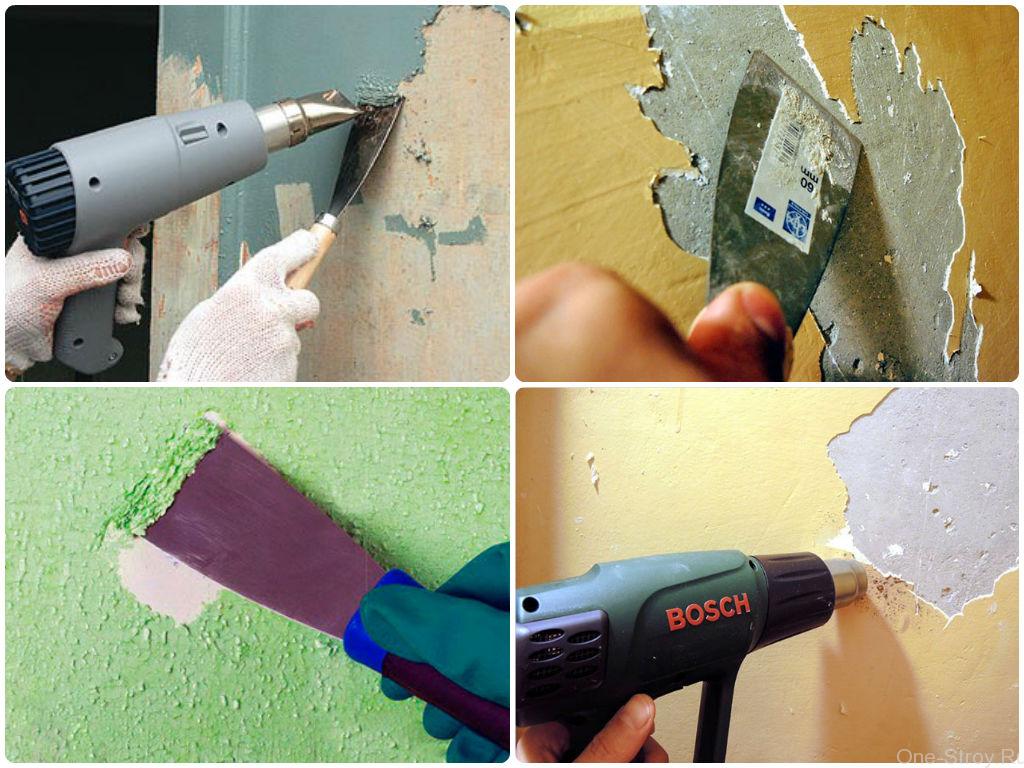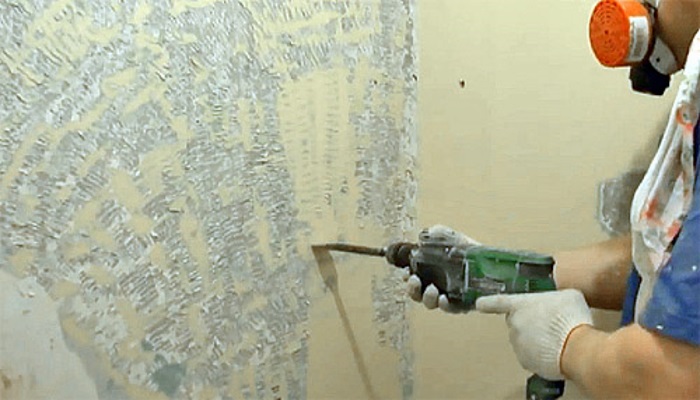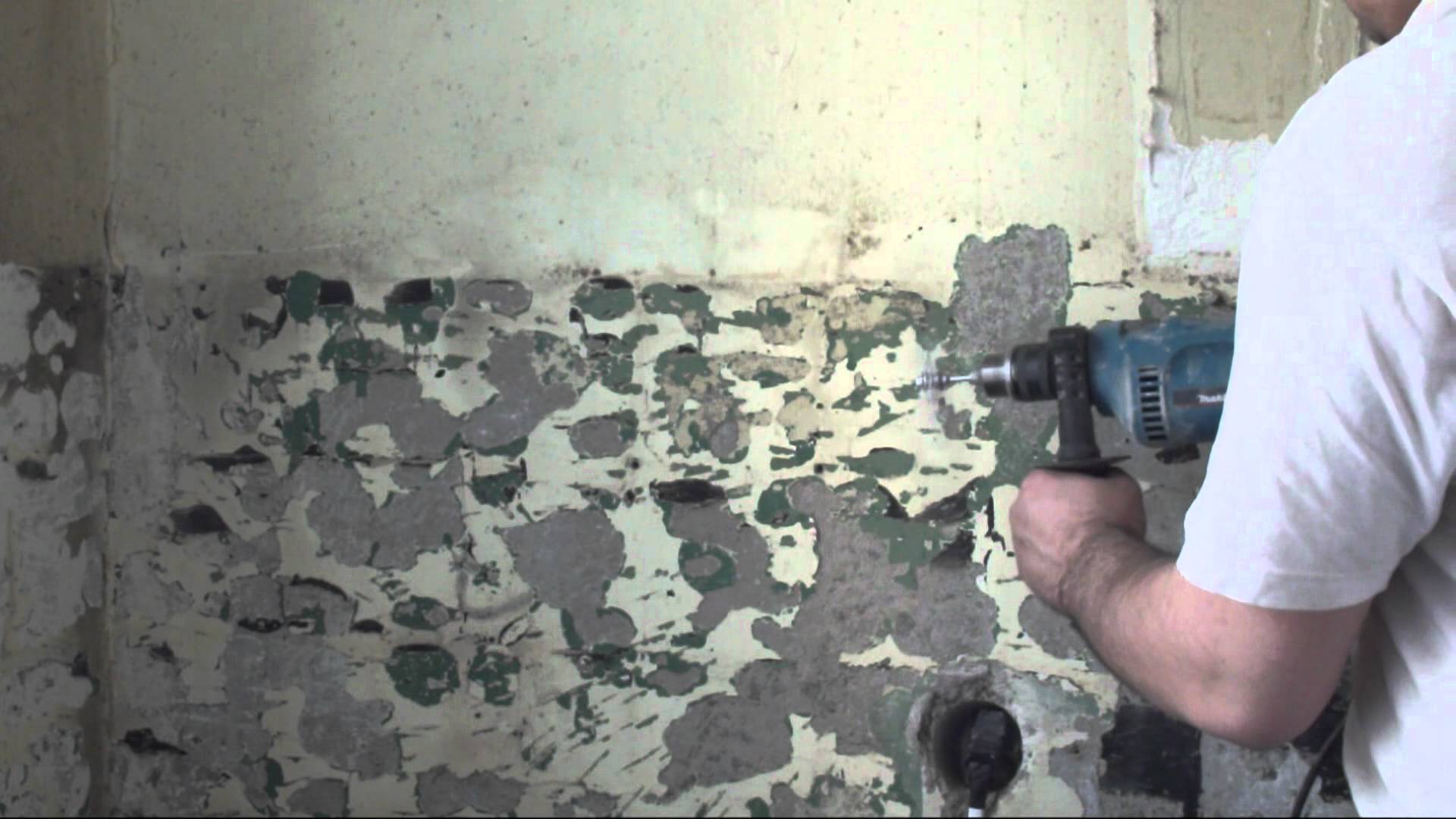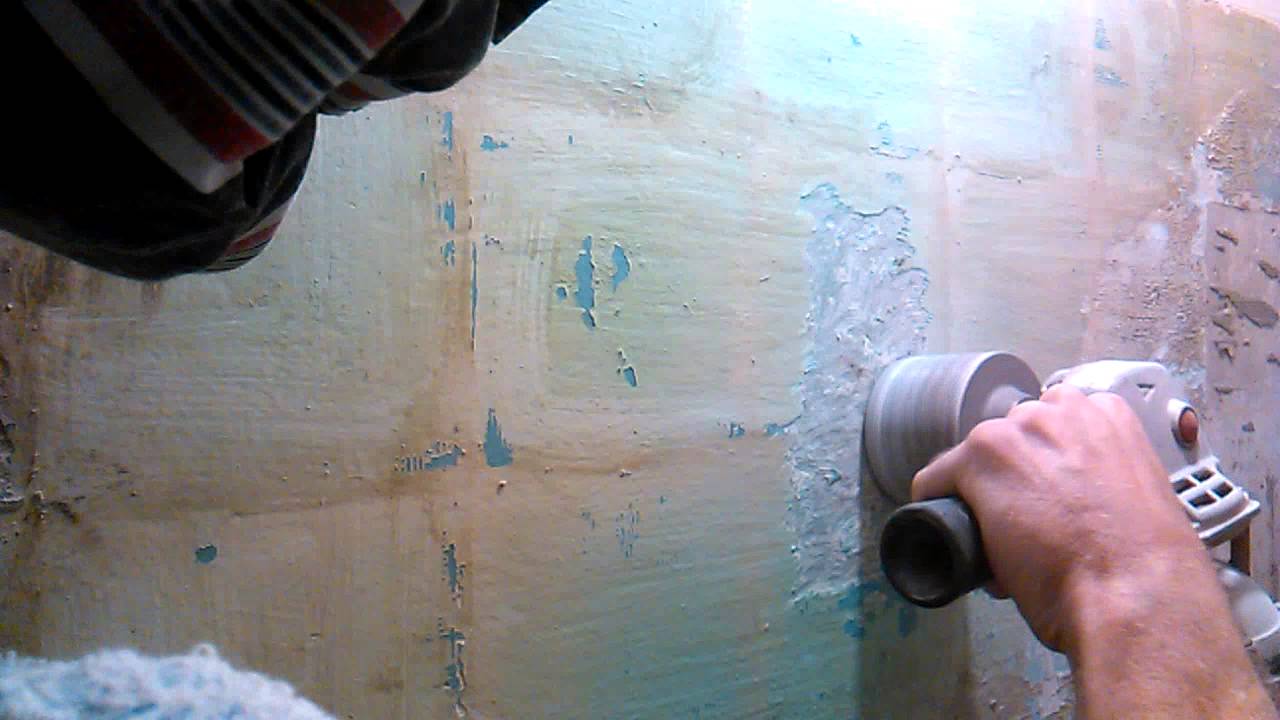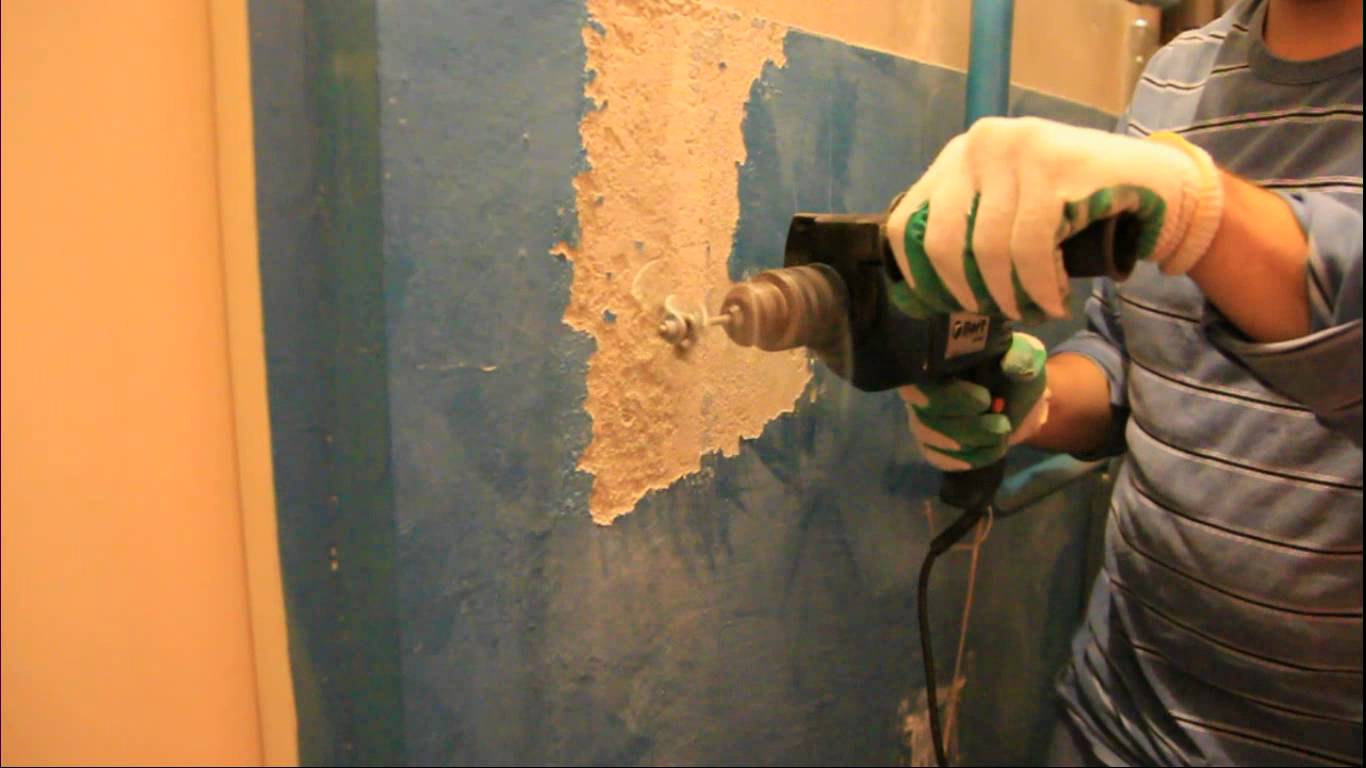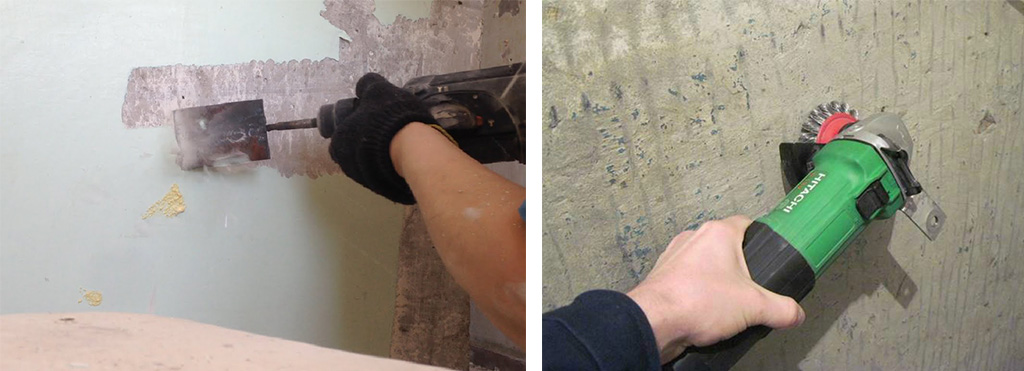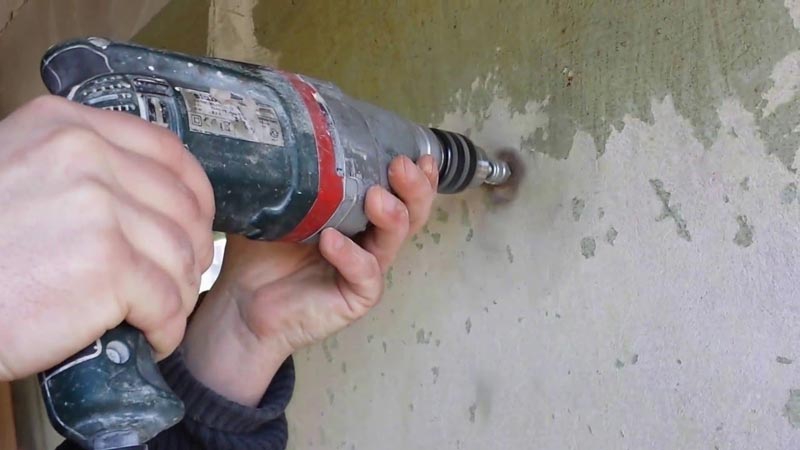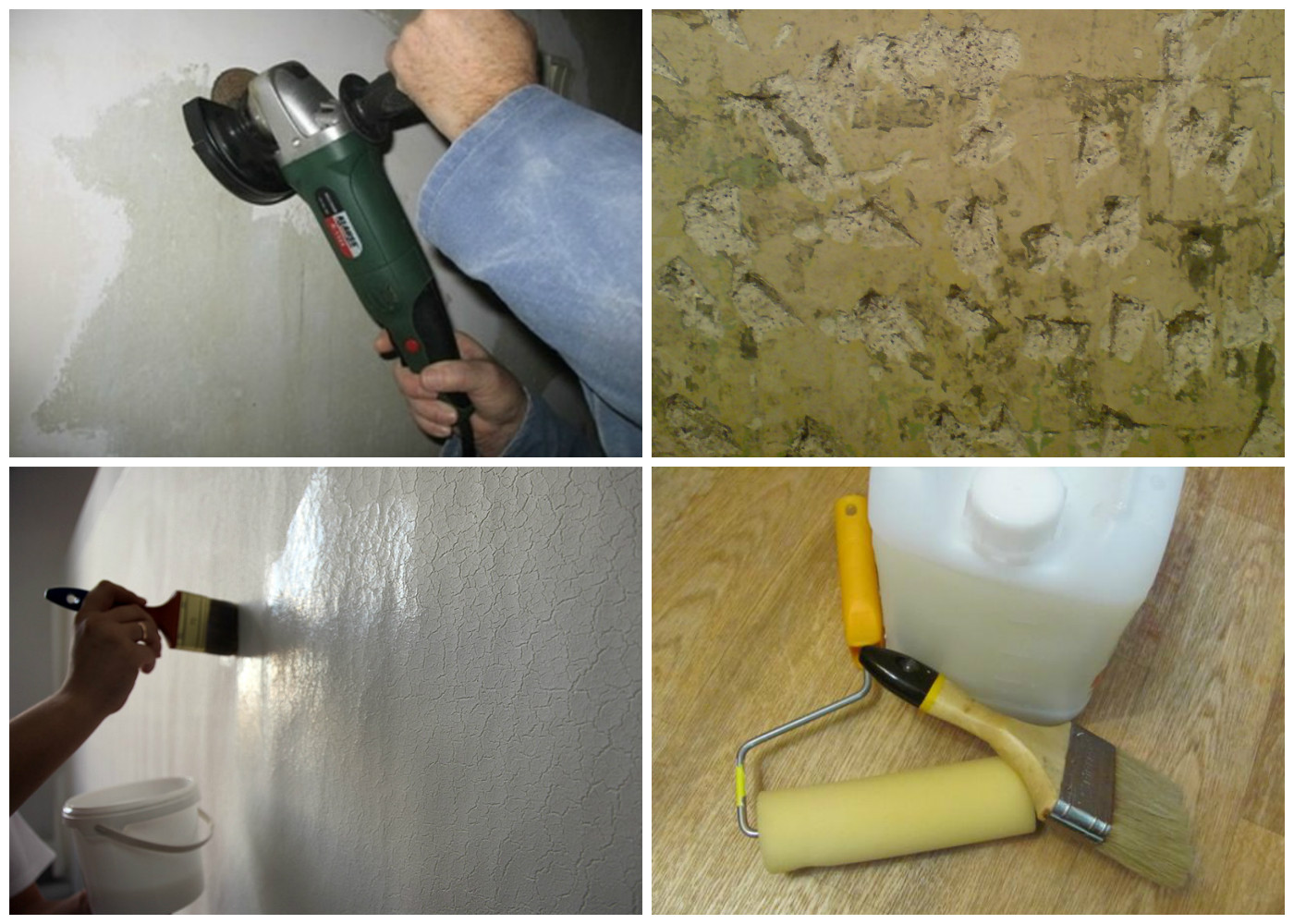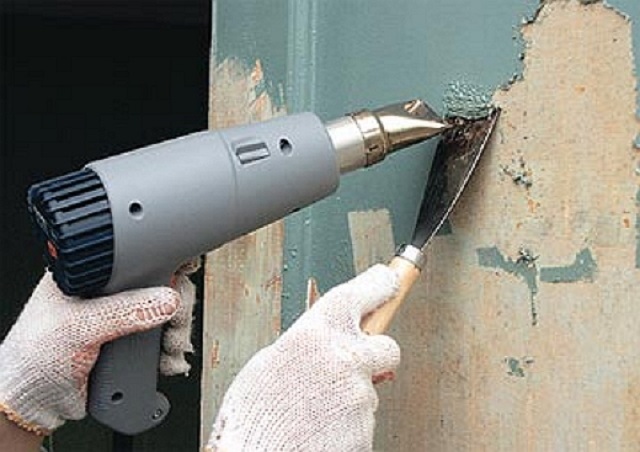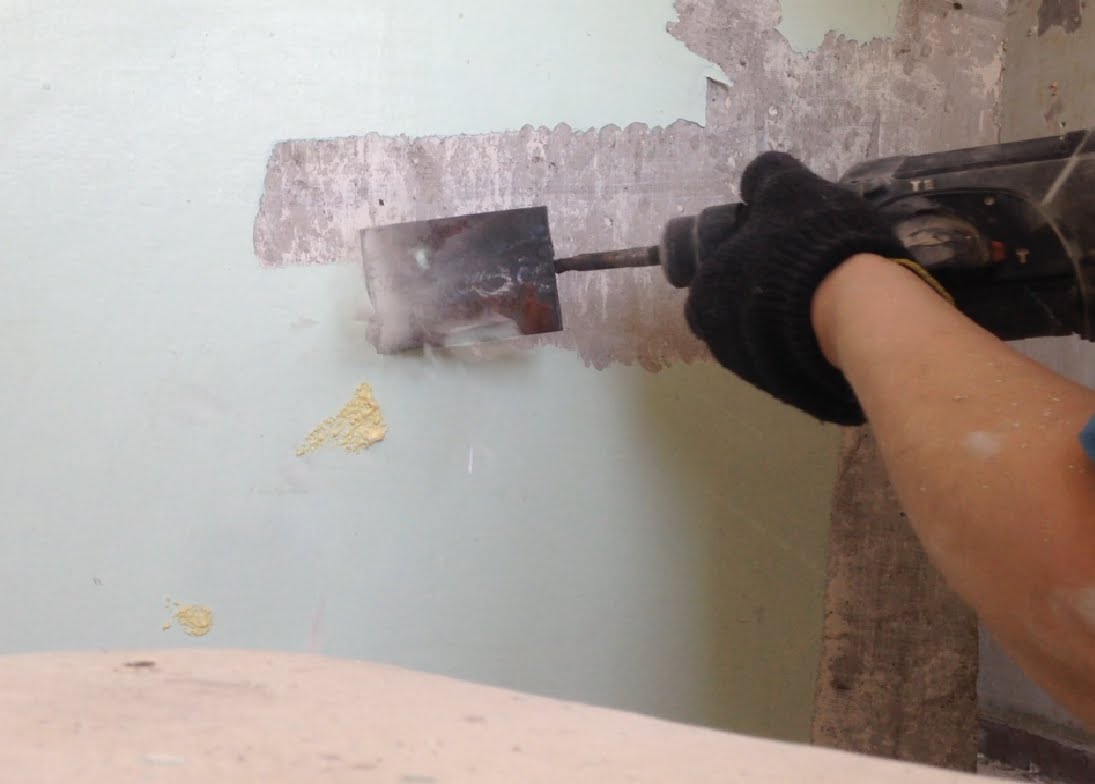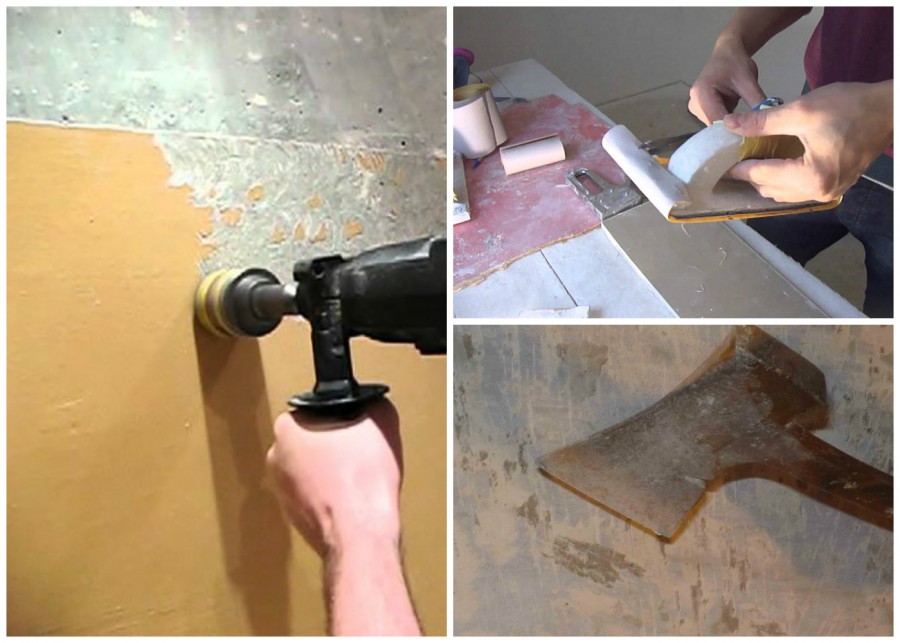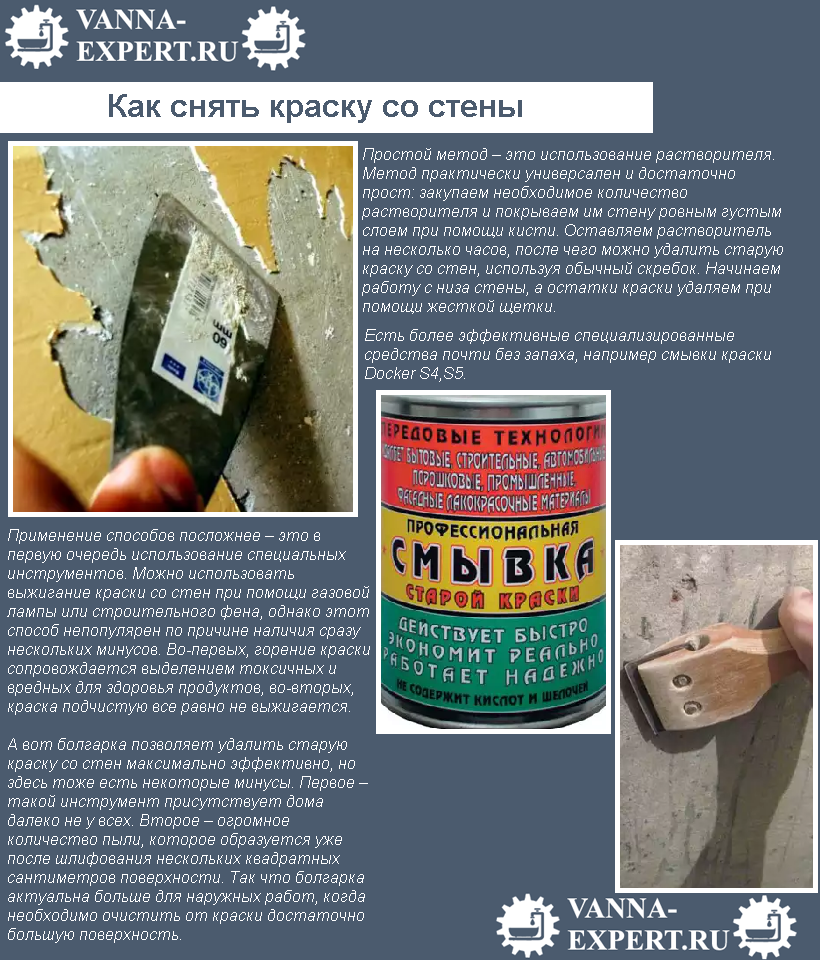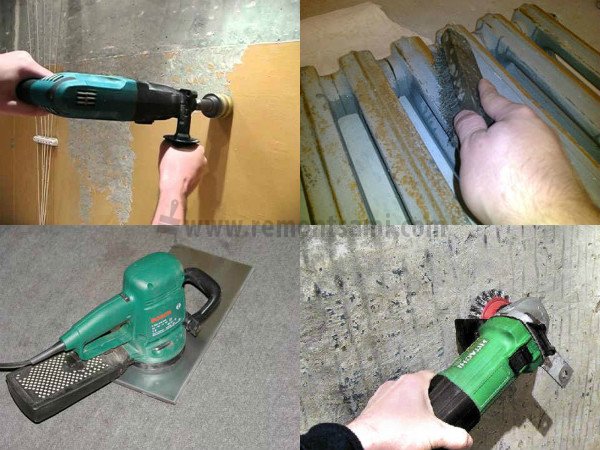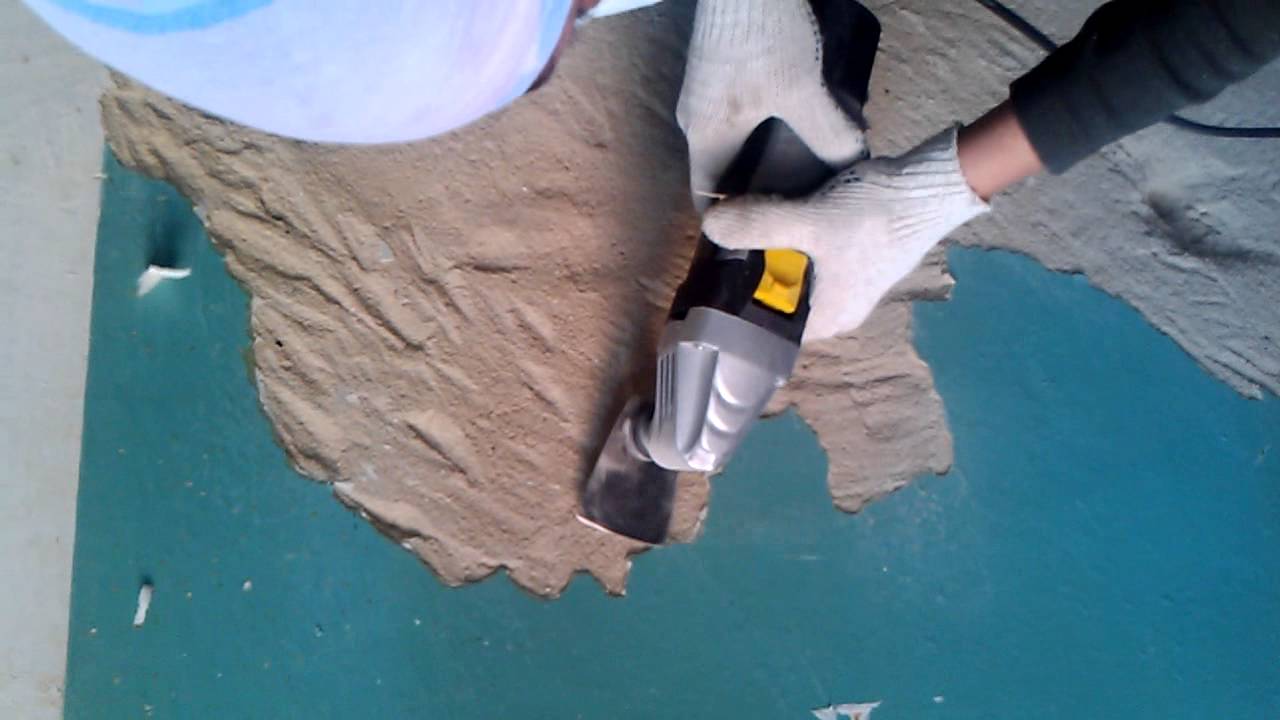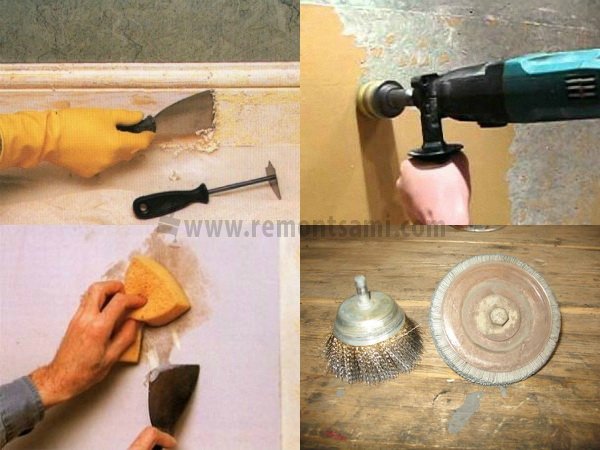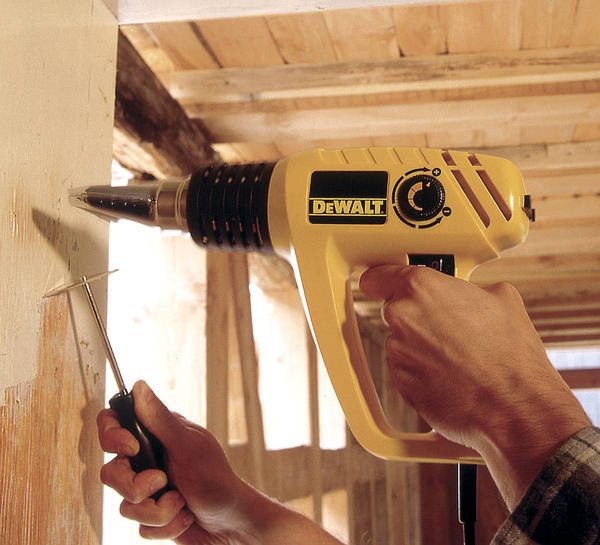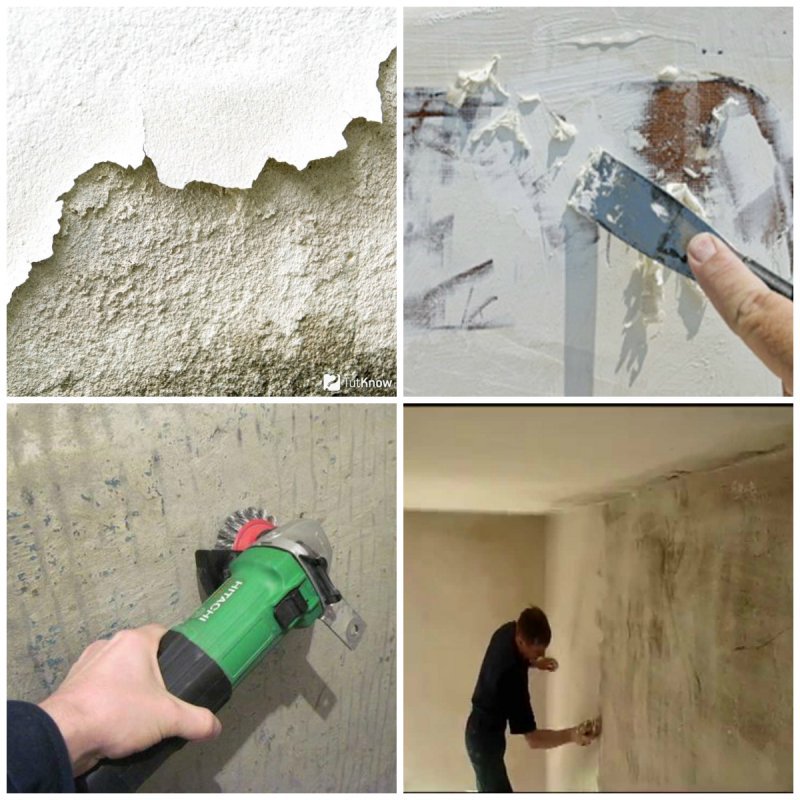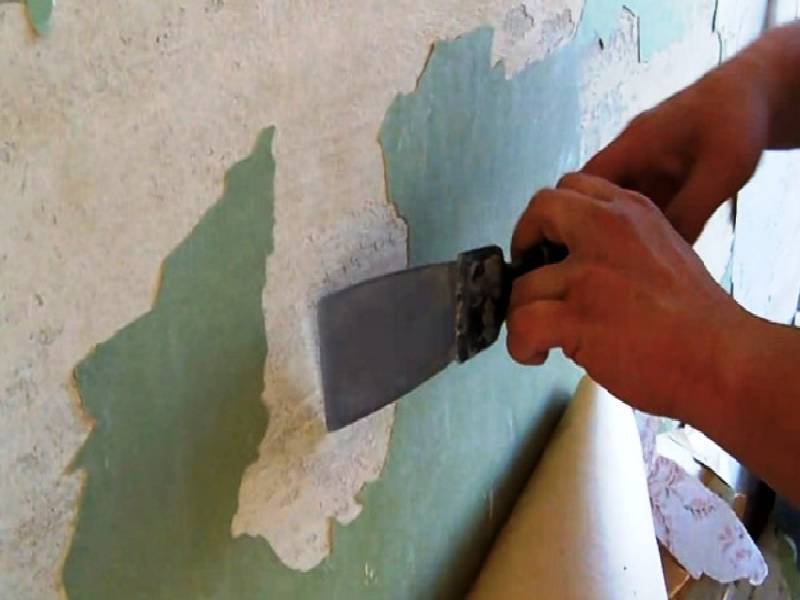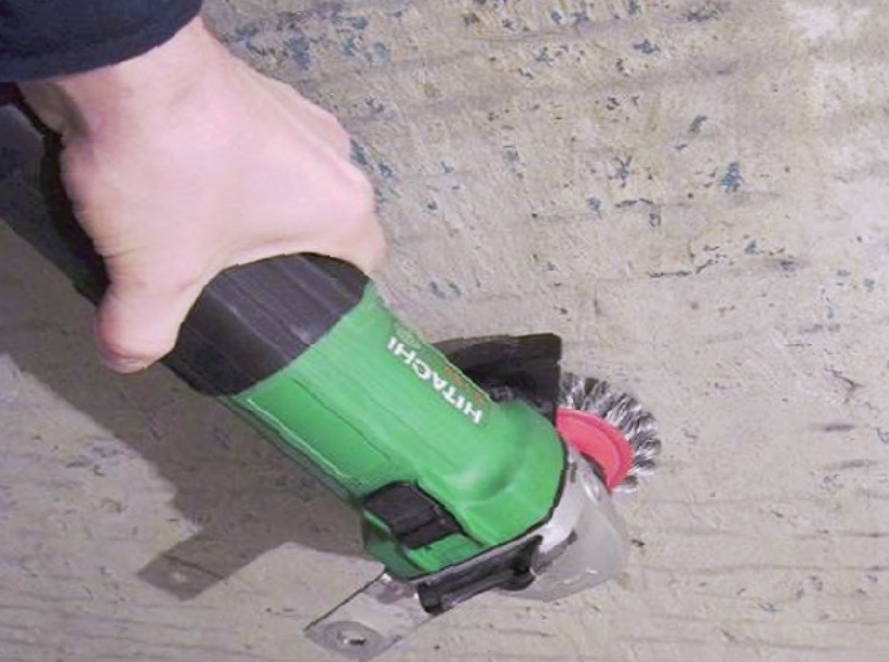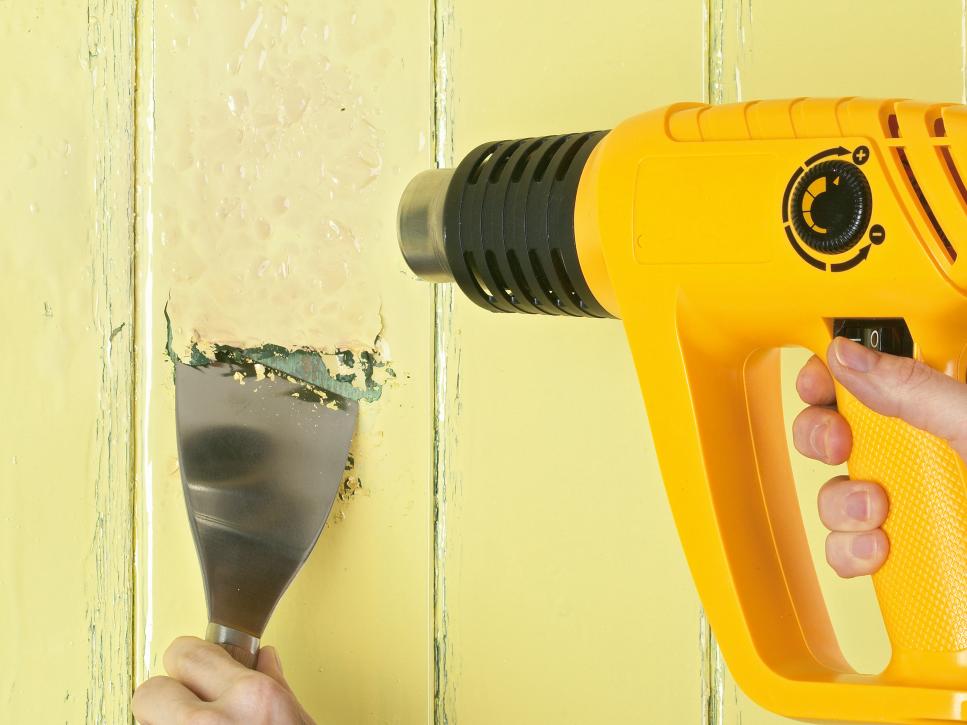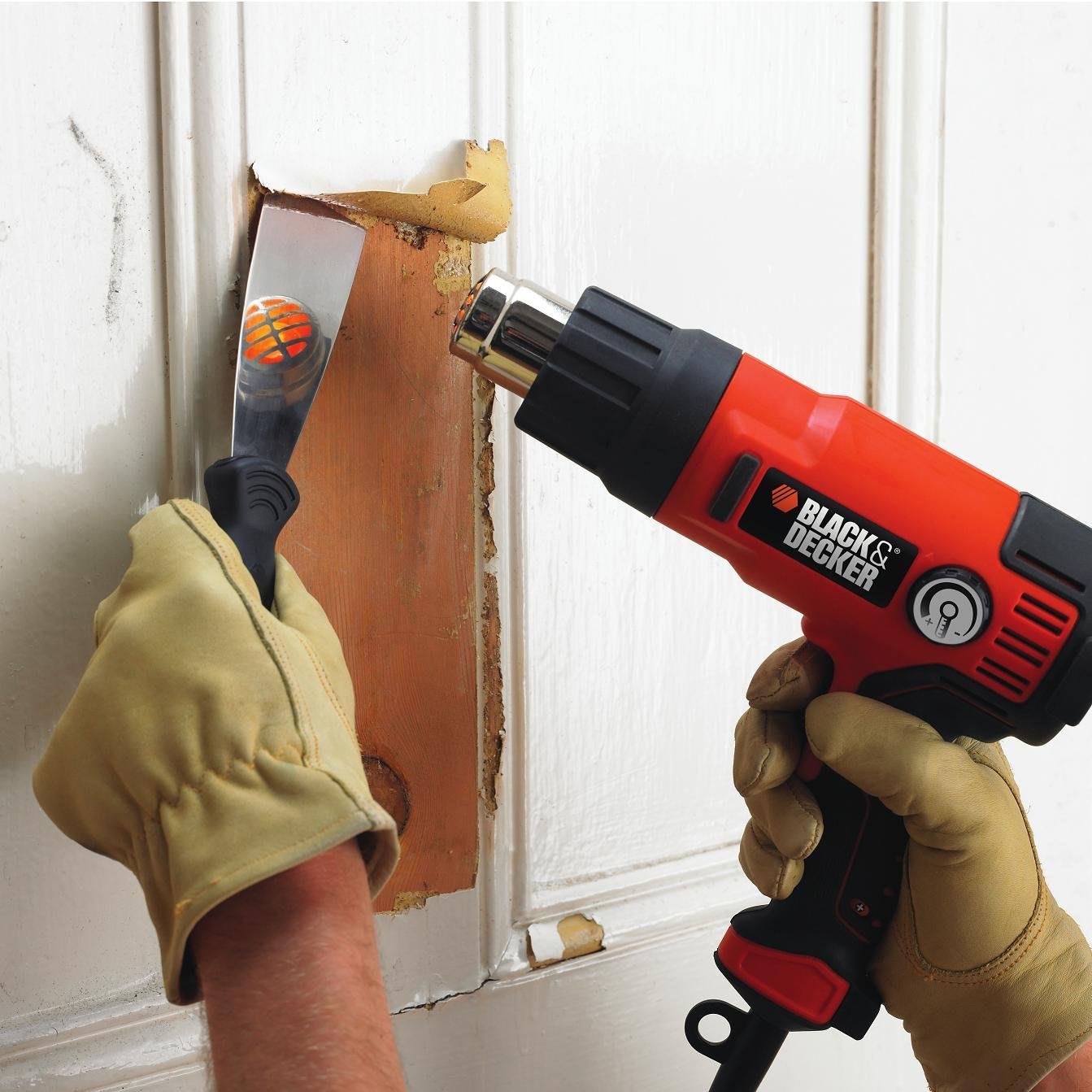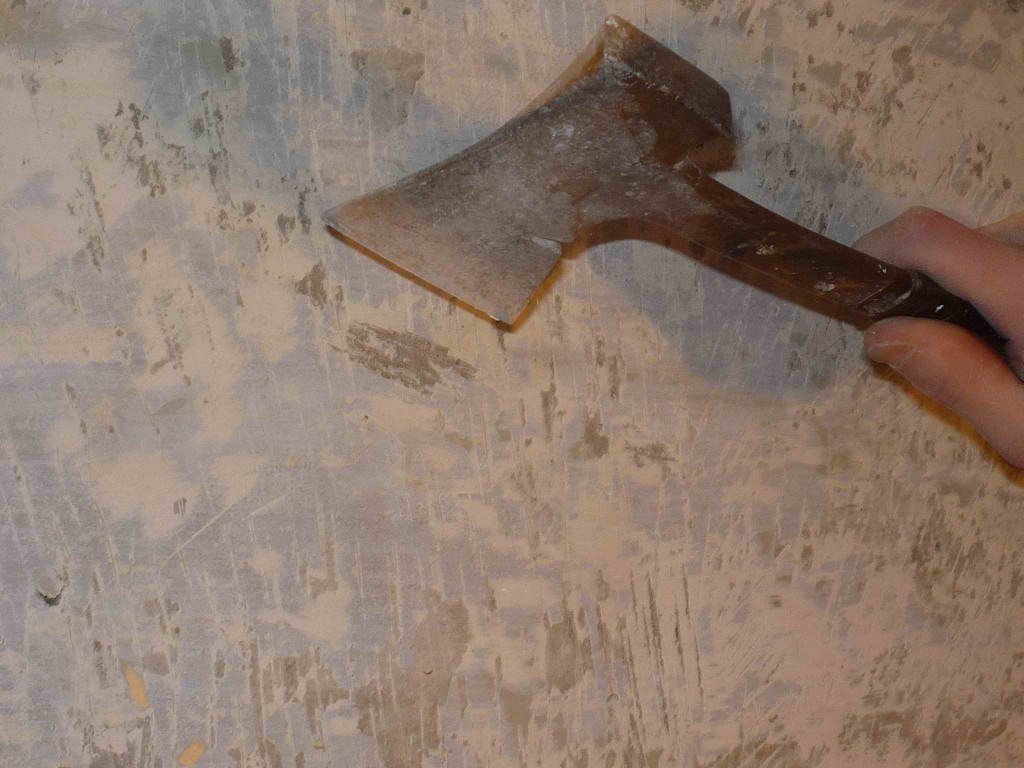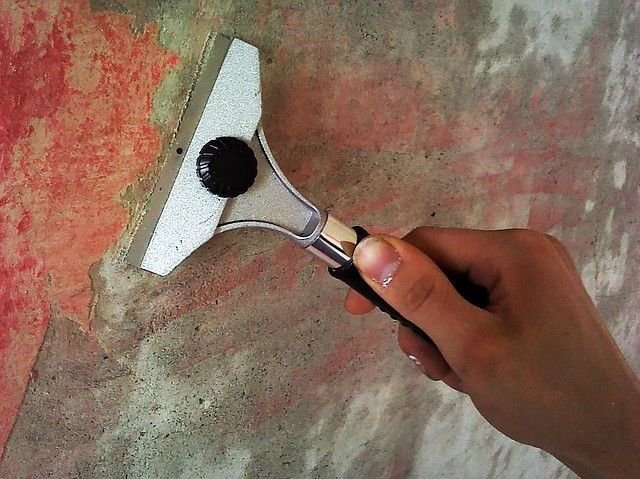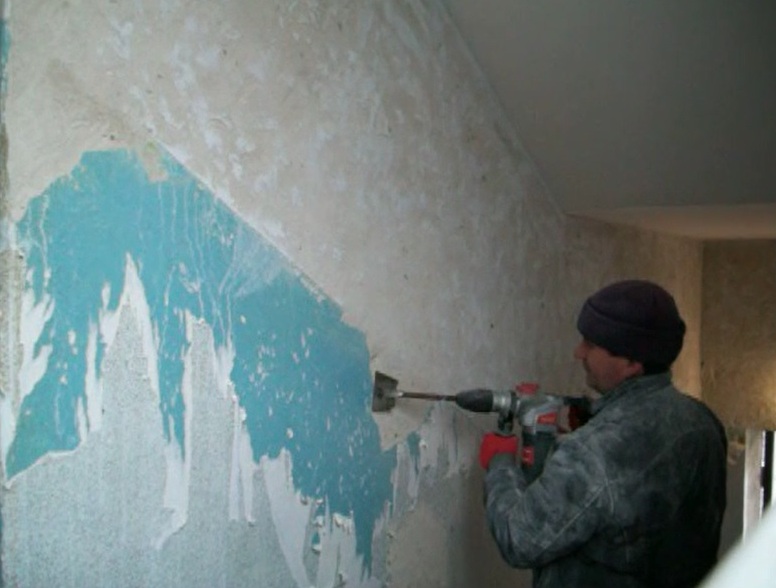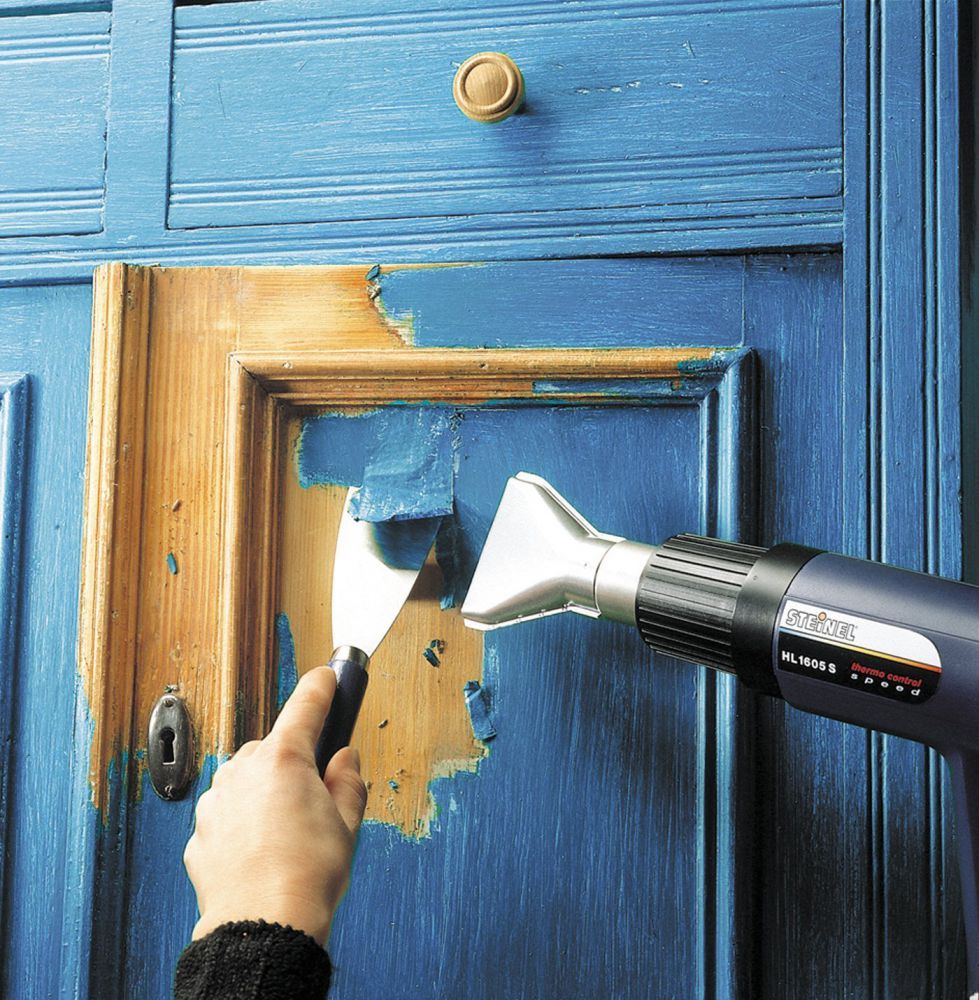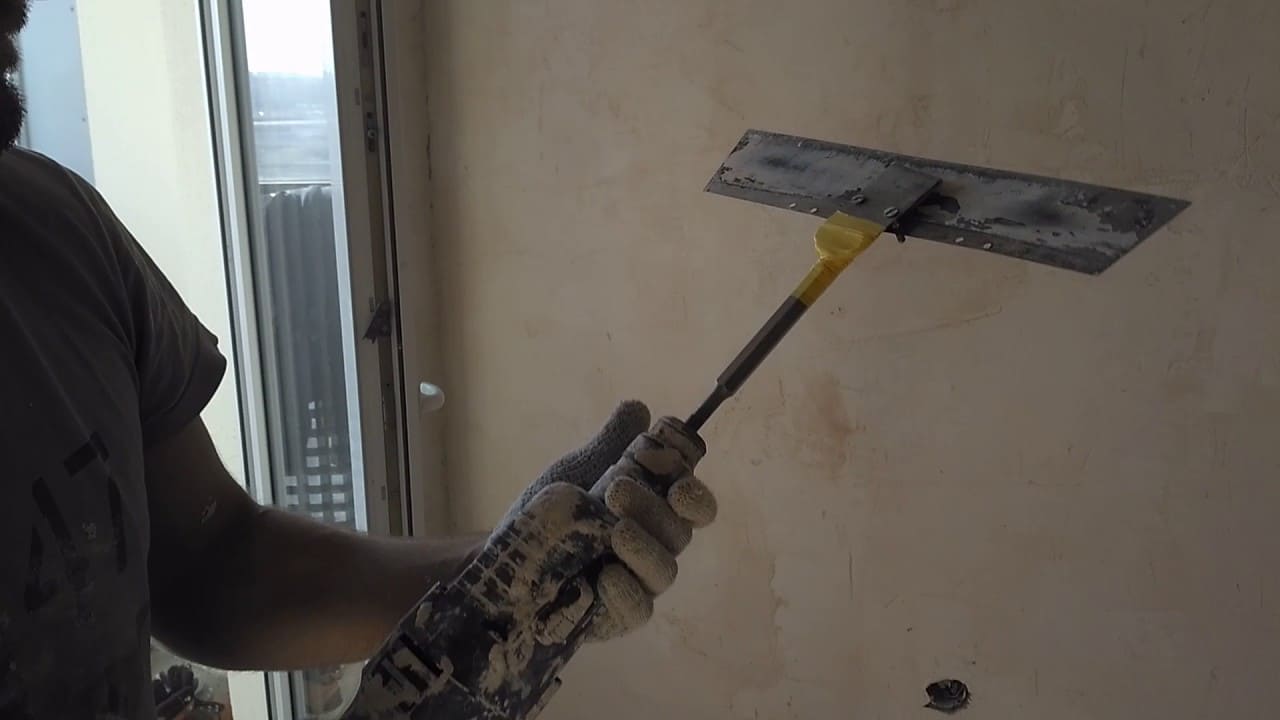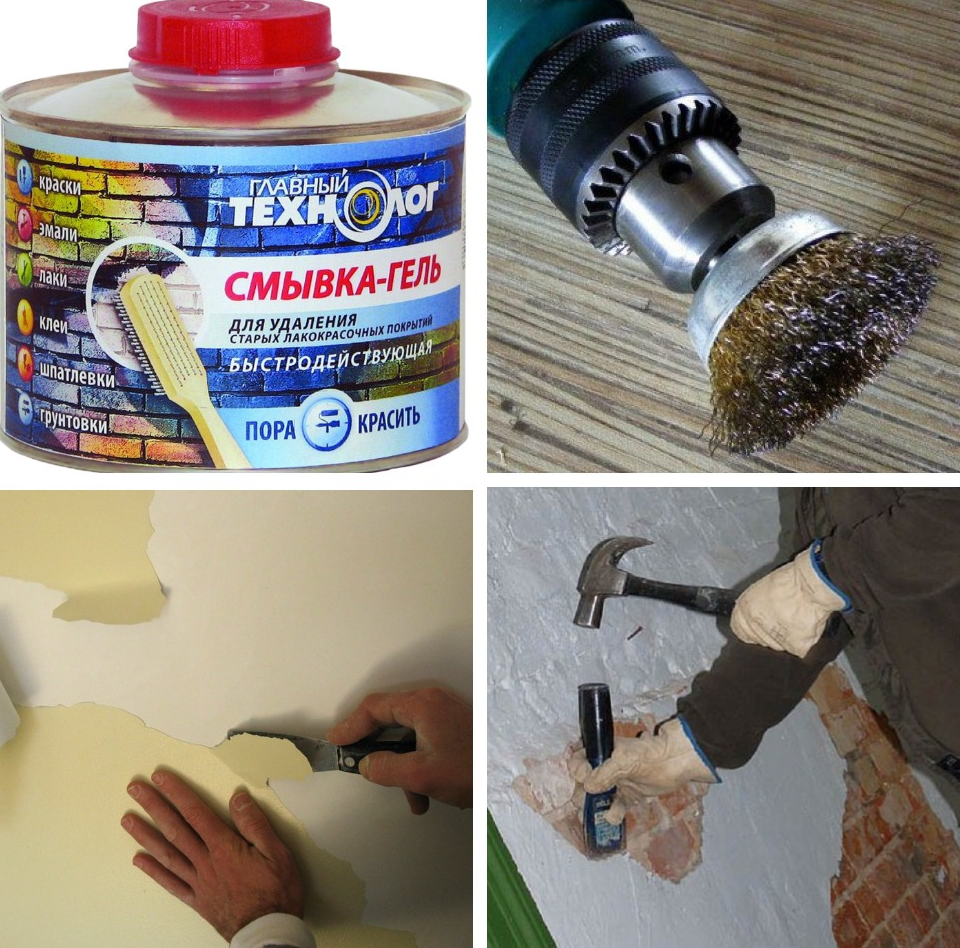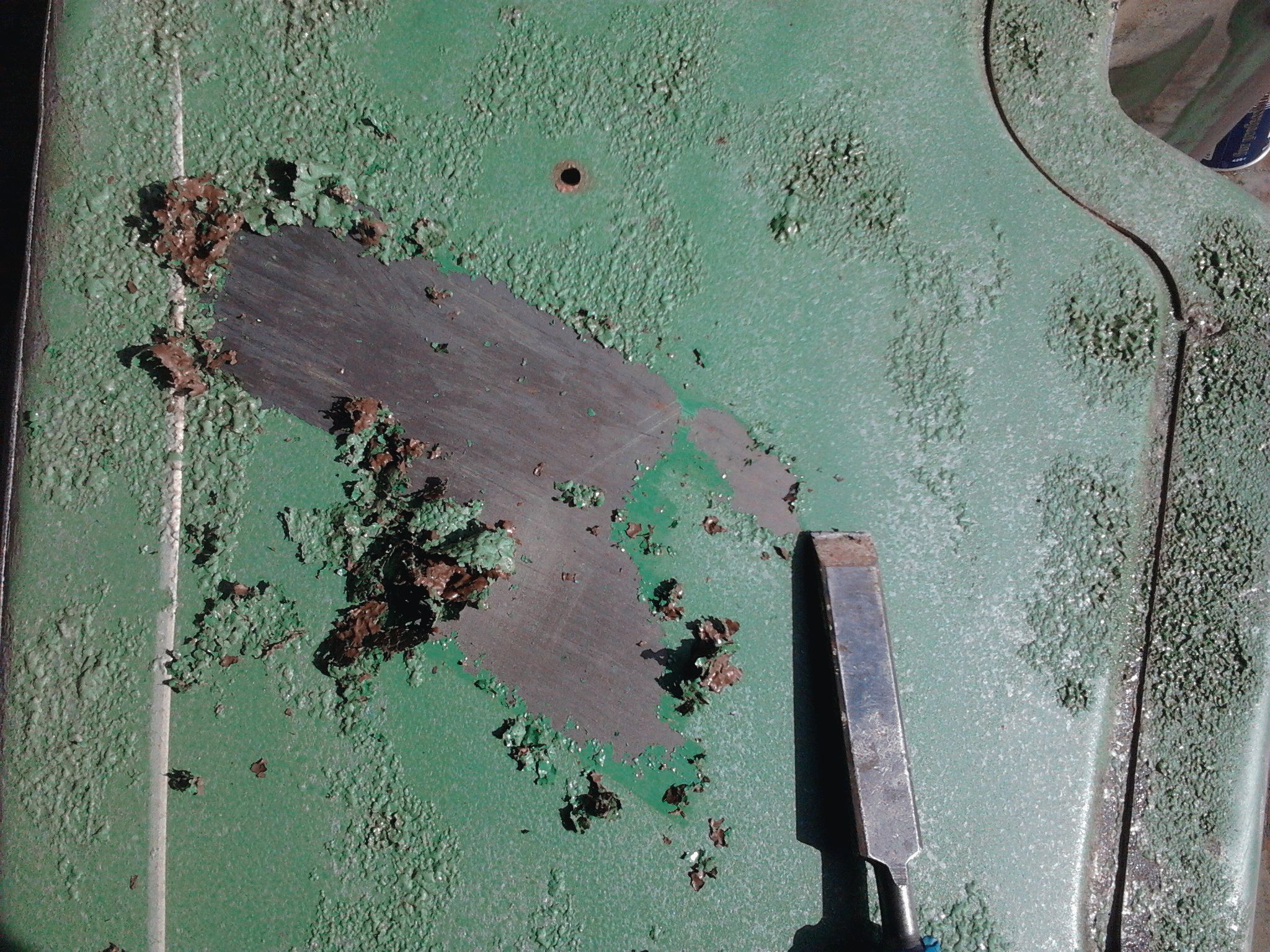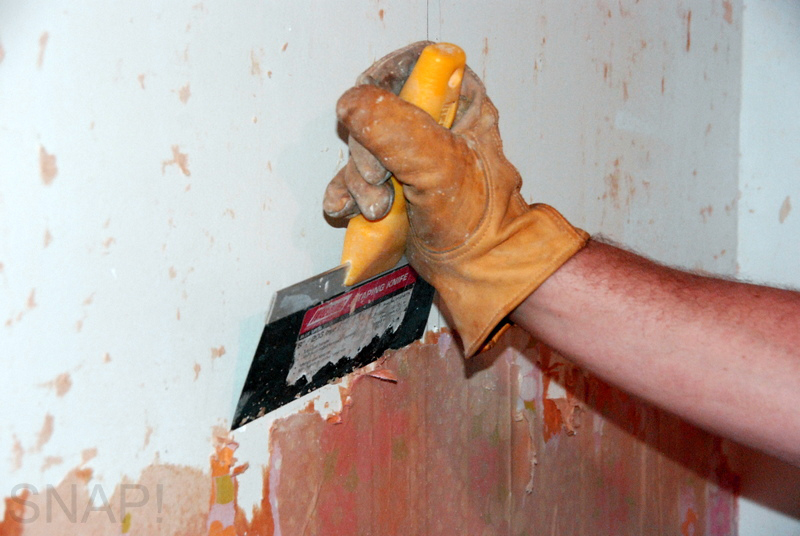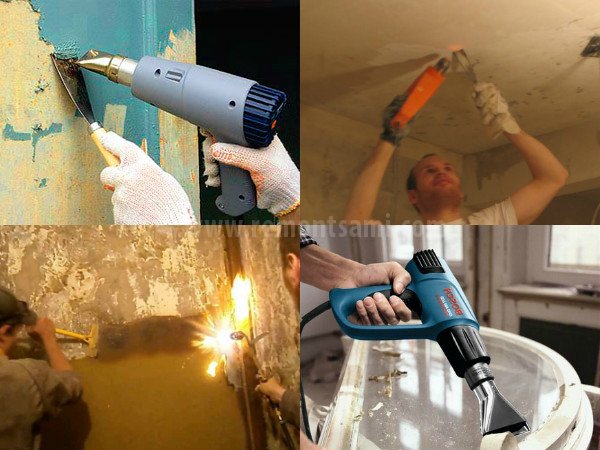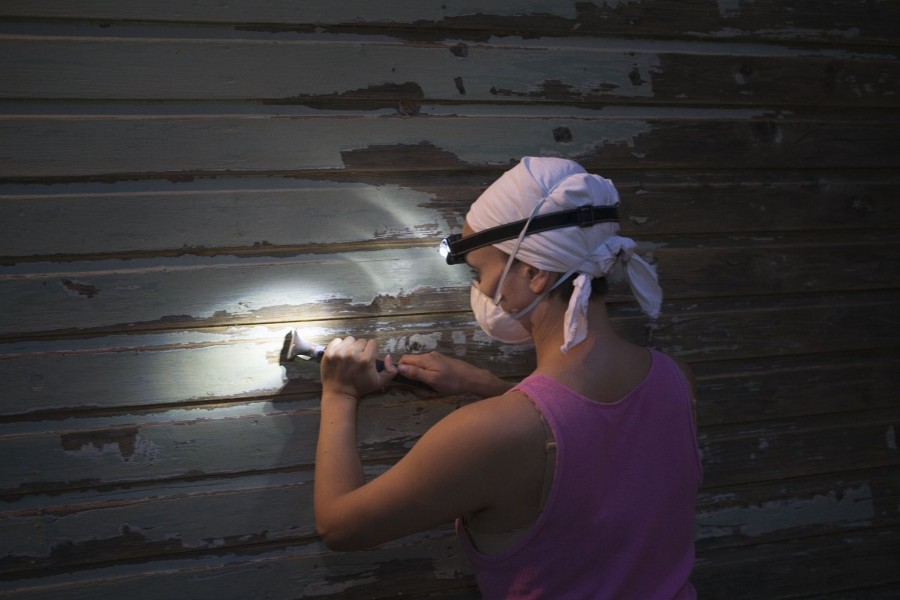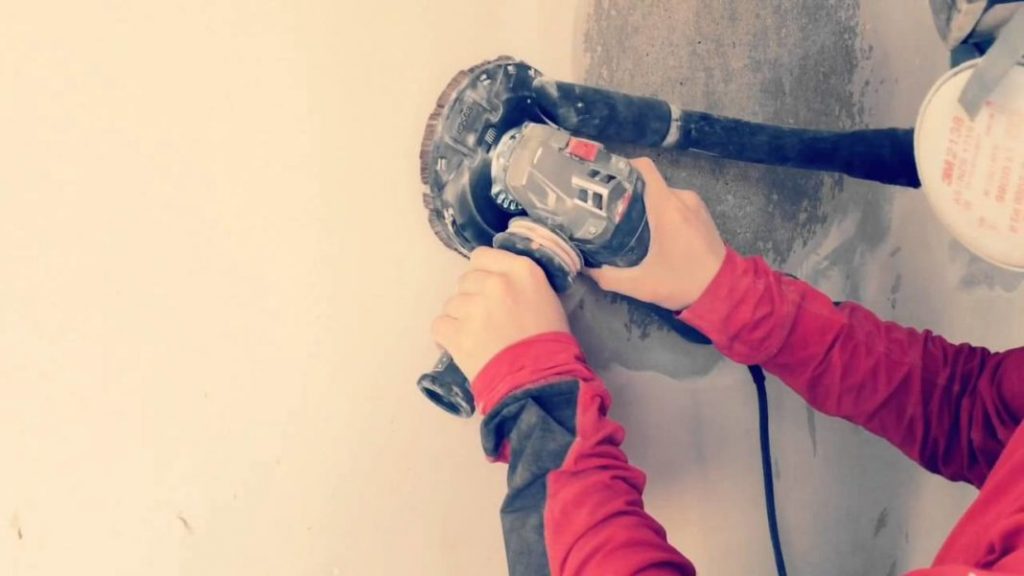Do I need to remove old paint
If, during the repair, the wall with the old paint will be covered with drywall, then there is no need to waste time fighting the remains. But if the plans include the processing of this particular surface, then the previous coating will have to be removed.
Otherwise, the tile will not stick (and even if it does, it will fall off very quickly), and the wallpaper will come off as soon as the glue dries. It is generally impossible to predict how the new paint will behave on the old one. 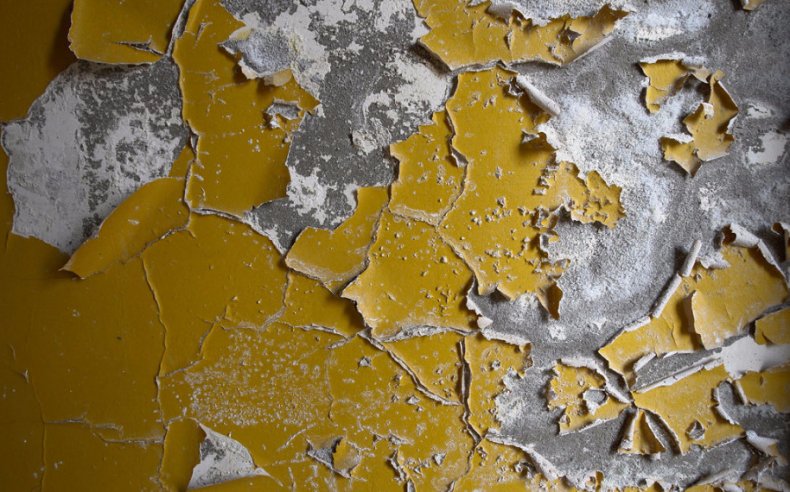
Did you know? The word "renovation" comes from France. It was originally used in the army to mean "change an old horse to a young one."
- what paint is on the wall now, how many layers;
- what type of surface we are dealing with;
- what tool is available;
- the budget of the event.
Most often, it is the first point that causes difficulties. The paint can be acrylic, water-based or oil-based. If an experienced master manages to determine the type of painting by eye, then it is not possible to guess the layers. Therefore, it is recommended that you select a small section of the wall for experimentation so that you can determine the most effective cleaning method in practice.
The type of surface is usually easy to distinguish even for a novice craftsman: wood, metal or concrete. The most difficult combination to remove is oil paint and concrete.
Let's dwell on the instrument in more detail. 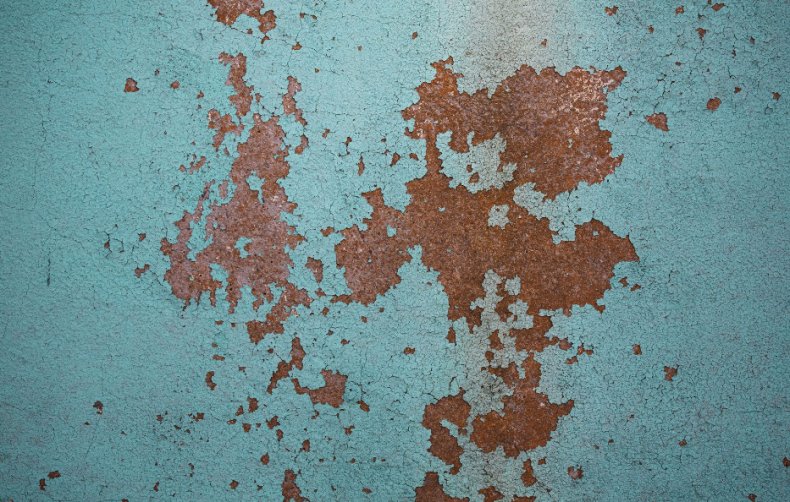
Learn how to build a ventilated cellar, a sheepfold, a ventilated chicken coop, a veranda, a gazebo, a brazier, a do-it-yourself fence.
Chemical methods
Methods for removing old coatings using chemical reagents can be called the least laborious. You just need to carefully distribute the product on the surface, let it act on the paint for the recommended time, and then remove the softened coating.
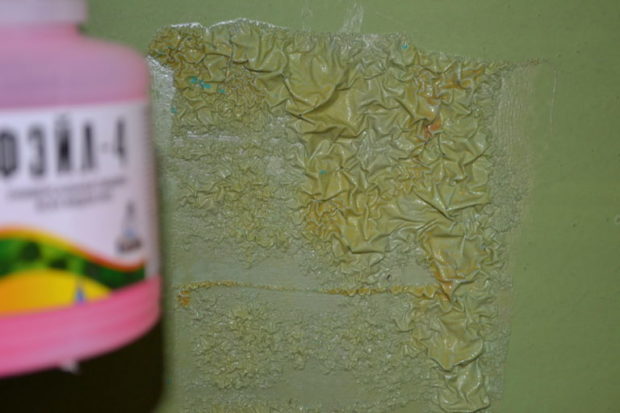
No. 9. Ready-to-use paint stripper
The time interval is always indicated on the packaging, as well as the recommendations for use, which we advise you to follow in strict order.
All chemical compounds have pungent, unpleasant odors and are highly corrosive. Be sure to work with gloves and a respirator, and for the duration of the solution it is better to leave the apartment altogether, opening the windows for ventilation;
Also, after the end of the work, you cannot just take and pour the remaining solution into the sewer. Chemicals are highly corrosive and must be disposed of properly. This is also mentioned on the packaging or in the instructions;
The cost of such funds can also scare off, but believe me, after you try to remove the paint with a spatula, ax or grinder and none of the above will give the desired result, you will not want to save
Often, one liter of solution is enough to remove paint from the walls of a bathroom and toilet of standard sizes;
Pay attention to the fact that some formulations may be intended for use only on horizontal surfaces.
Depending on the component of the base, ready-made compositions are:
- Acidic - based on hydrochloric or phosphoric acid;
- Alkaline - based on salts of various origins;
- Organic - which do not contain any salts or acids.
For removing old paint from a stone surface, acid-free formulations are considered most suitable.
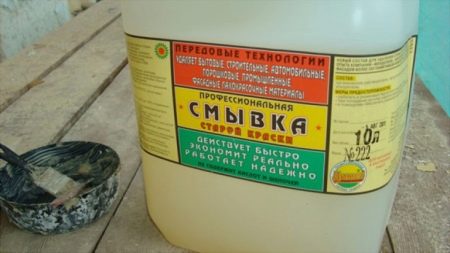
According to the form of release, solutions can be in the form:
- Liquids - alkaline or acidic concentrates to be diluted;
- Gels - have a milder effect and are produced on the basis of organic compounds. More convenient for indoor use, as they do not have such a strong odor;
- Powders - used both in the form of solutions and independently;
-
Aerosols - Designed to work in small areas and are very convenient.
It is not difficult to choose a composition for a certain type of paint. In order not to be mistaken in choosing a remover, it is better to purchase universal solutions that are suitable for removing any type of paint. For example:
-
Fail-5 remover is designed specifically to remove old paint and dissolves even powder formulations. Begins to act a few minutes after application. You will see how the old coating will start to cover with small cracks;
-
"Antikras" is a universal quick-acting remover suitable for removing paint not only from walls, but also from the floor, stream, metal, wood, plastic;
-
Docker S4 is a general construction remover used to remove all types of paintwork.
No. 10. How to make a wash with your own hands?
Still, you can try to save money and prepare a paint remover yourself:
-
It is necessary to mix 250 ml of ammonia with a liter of cold water. The alcohol should be 10%. Add 2 kg of regular chalk to the resulting liquid and mix thoroughly until a pasty mixture without lumps is formed. The resulting slurry is applied to the wall in a uniform layer. After a couple of hours, you can start removing the paint. Such a composition should not destroy the paint layer itself, but break the strength of its adhesion to the base material;
- Another popular method is to mix 1.2 kg of quicklime with 400 g of soda ash, then add water. The mixture should resemble thick sour cream in consistency. It is applied to the wall for at least 12 hours;
-
You can use liquid glass. It is applied in a thin layer over the old paint. After drying, a thin silicate film forms, which should peel off along with the paint.
Typically, the above methods do a good job of either removing recently applied or worn coatings. For strong layers of paint, it is better to use ready-made, special washes.
Removing paint from the wall
The speed and quality of removal of the coating depends not only on the method of cleaning, but also on the material of the wall.
With concrete
Concrete is the most difficult in this regard, it is rarely possible to cope with it with the help of chemistry. Such tools will only help on concrete floors and in the case of fresh paint.
Cleaning with a hairdryer and hot air is a little more effective, as long as it is not an oily coating. The process will take a lot of time and will require a lot of effort, therefore, when working with concrete, many people prefer mechanical methods of removal.
An ax and a chisel will be ineffective in large areas, but a hammer drill will fully cope with such a task with the least amount of time.
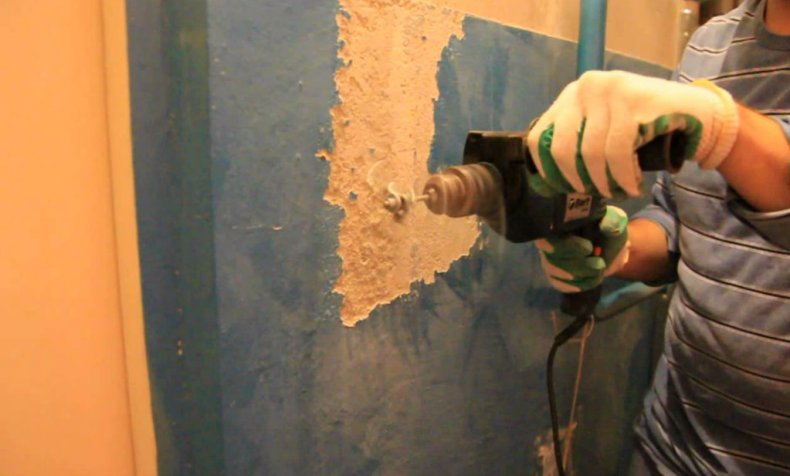
With metal
For painted metal, blowtorch burnout is best, but it is absolutely unsuitable for enclosed spaces. If the paint crumbles well, and you need to clean a small area, then first you can try to do this with sandpaper, a metal brush, a drill with a paint remover. It is quick and convenient if you do not need to process a large surface.
Did you know? Many metals (nickel, cobalt) were named after the mountain spirits that aided the miners in Germany and Scandinavia in the extraction of these materials.
The thermal method is poorly suited in this case, since the material quickly gives off heat and it is extremely difficult to heat it to the desired temperature. 
With wooden
But for removing paint from wooden surfaces, a construction hairdryer is the very thing. The wood reacts well to heat, the coating quickly begins to bubble and can be easily removed with a spatula or chisel. The main thing in this process is not to damage the wood itself with the sharp edges of the tool.
All kinds of chemicals do well with cleaning wooden surfaces. You can take, for example, caustic soda with water (2: 1) and dilute it into a liquid slurry.This mixture should be applied to the surface until the paint begins to swell. After that, take the spatula again and remove the remains.
Important! The cleaned wood at the end of the procedure should be covered with a degreasing solution for better preservation.
Whichever method of cleaning you choose, it is always worth remembering personal protective equipment, since there are a lot of harmful fumes and dust during the repair process. Also, do not forget about the features of each method and the nuances of its application on a specific material. And then the old paint will not interfere with the new fresh design.
When to remove old paint and why
More often, during repairs, the removal of oil, sometimes water-based paint is required. This need does not always arise, depending on the type of finish chosen.
You can leave the old paintwork material in the following cases:
- The walls are to be finished with plasterboard.
- Clapboard or wall panels are used as decoration.
- When re-painting, when the coating is strong, there are no chips, bubbles or cracks. Sometimes you will have to remove the exfoliated areas by filling the base with a finishing putty. This method is not suitable if water-based or acrylic paint will be applied over the old oil paint.
More often you have to remove paints:
- oil;
- water-based;
- water-dispersive.
The tools and materials, as well as the method, should be selected taking into account the type of old coating.
 With the mechanical method of removal, you can use both a hand tool and a power tool with special attachments.
With the mechanical method of removal, you can use both a hand tool and a power tool with special attachments.
How and how to remove old paint from walls, ceiling and floor
Let's start with the first factor - the type of paint, which depends on
a type of film-forming base that binds the coloring pigments into a single
homogeneous mass. Full characteristics and marking of paints are presented in
table. We will focus on some of the most popular types.
-
Water based paint... Coloring pigments are distributed in
water based. But, despite this, the water emulsion is not washed off with water after
solidification. This is perhaps the only type of paint that can be applied
any other, without the risk of ruining the work. -
Acrylic paint... It is made on the basis of acrylic resin.
Differs in elasticity, frost resistance, low gas tightness,
durability and UV resistance. -
Oil paint... Everyone faced the question of its removal,
who received an apartment from the state. The basis for its manufacture is linseed oil, and
an alkyd resin acts as a binder. Over time, the surface
painted with oil paint, loses its color, but, nevertheless, the paint does not
loses its structure.
The base of the paint determines the degree of its wear resistance.
The second factor, the type of surface, is also important. He
influences the way the paint is removed.
Removal features depending on the type of paint and base
Before you start removing paint from the walls, you need to assess the situation:
- determine the type of paint and the base under it;
- decide how much time and money you are willing to spend;
- choose a suitable paint removal option.
Types of paint
To determine the type of paint, start with a visual assessment. Enamel and oil paints have a glossy surface. Water-based compositions are easily washed out with water. Acrylic does not shine and does not dissolve in water.
Water-based
Often used on ceilings and in dry rooms, removing this paint from the wall is as easy as shelling pears:
- Pour warm water into the basin.
- Dampen a roller or rag in water, dampen the walls.
- Wait 15-20 minutes.
- Remove the coating with a spatula.
Tip: Before starting work, cover furniture and floors with plastic foil.
Instead of a roller or rag, it is convenient to use a pump sprayer - fill it with hot water and spray. It is also convenient to soak the wallpaper.
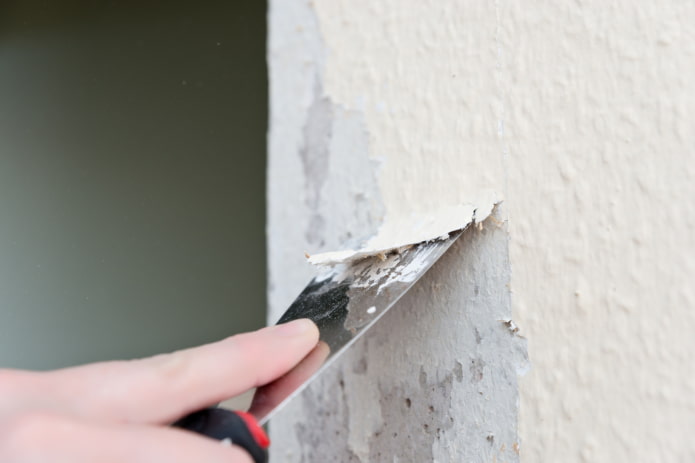
Acrylic
Unlike water-based paints, this one will have to be scraped off, while working on a dry surface.
You can remove acrylic paint from the walls in a bathroom or another room using coarse sandpaper - however, it will take a long time to rub and you will need more than one sheet.
Another option is temperature. Heat up the old paint with a construction hair dryer and remove it like a film. A detailed technique is described in the video.
Tip: If you plan to re-apply acrylic paint to the walls, the old coating does not need to be removed.
Oil
the base, you will have to try. A solvent will help to remove the oil paint from small areas, however, it has a pungent odor and if the room does not have sufficient ventilation, it is better to refuse this option.
Proven temperature method for removing paint from walls:
- Heat the area with a building hair dryer.
- Remove paint with a spatula.
Important: When heated, corrosive substances are released into the air, so you need to work in a respirator and in a well-ventilated apartment. The safest, but time-consuming method is mechanical
A hammer drill with a special nozzle will help speed up the process, the process is described in the video:
The safest, but time-consuming method is mechanical. A hammer drill with a special nozzle will help speed up the process, the process is described in the video:
To reduce the negative effects of vibration on joints, wrap the attachment with a rag or foam rubber.
Base
The choice of the way to remove the old coating, as well as its speed and complexity, is influenced by the base.
Concrete
One of the most problematic combinations is an old coat of Soviet oil paint on a concrete wall. However, due to the porosity of the material, it is not easy to tear off any composition from it. The plus is that you can use any method: mechanical, chemical or thermal.
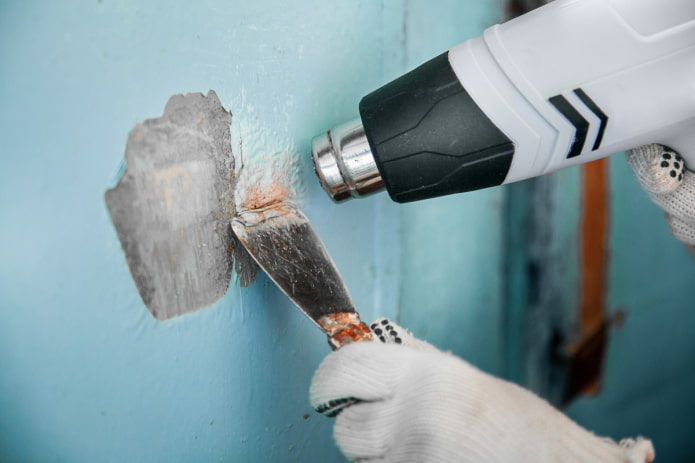
Plaster
Due to the ability of the plaster to swell, it will be easy to remove paint from the walls above it. The simplest order is:
- Make notches on the surface.
- Apply warm water using a roller or spray.
- Leave to act for 20-30 minutes.
- Remove the paint along with the plaster.
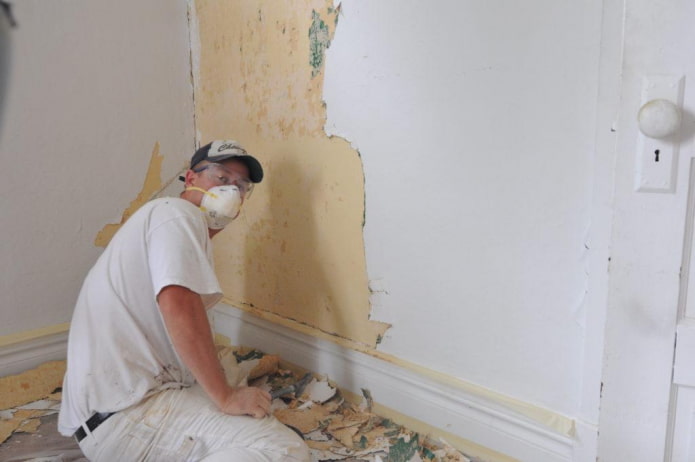
Brick
Any brick, whether silicate or ceramic, is defenseless against chemical compounds, so the use of a wash is swept aside. You will not only ruin the appearance, but also destroy the masonry itself. Harsh mechanical cleaning with sand or a hammer drill is also dangerous for bricks.
Recommended methods for removing old paint
Using chemicals
For work, you will need to purchase special cleaning agents made on the basis of organic or alkaline substances. The composition is evenly distributed over the working surface with the capture of a small fragment of the wall. For the interaction of chemical components with the paint, you should wait about 10 minutes, after which the slightly swollen coating is removed with a spatula or scraper. If necessary, the procedure is repeated in the same area 2-3 times.
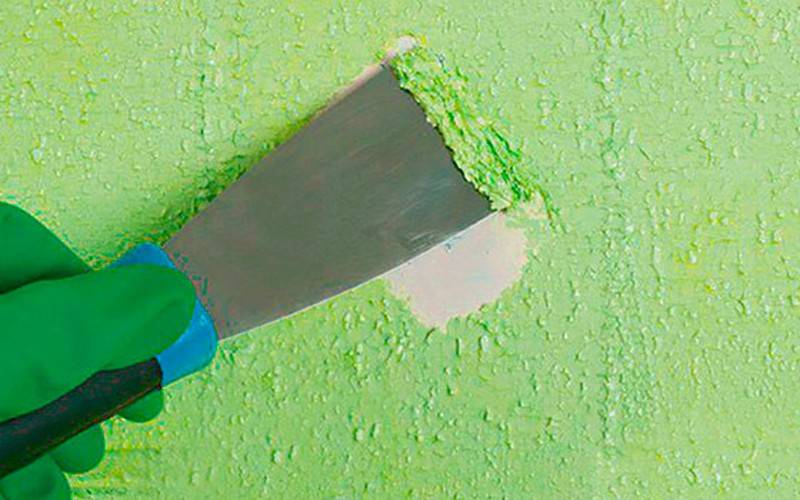
The advantages of the method:
• simple technology;
• stage-by-stage paint peeling without deformation of the base.
Disadvantages:
• for the purchase of funds, you need to provide a budget (when working in a large room, a lot of solvent will go);
• the chemical method is ineffective for coatings applied more than 2 years ago;
• acrid smell of solvents;
• for safety reasons, work is performed in overalls and a respirator.
Mechanical method
This method is considered popular due to the lack of a budget for the purchase of consumables and efficiency. True, it is worth considering that it is also the most time consuming. The essence of the work consists in processing the wall with an ax (you need to make as many notches as possible), followed by cleaning the paint with an abrasive brush, which is used as a nozzle for a drill or grinder.
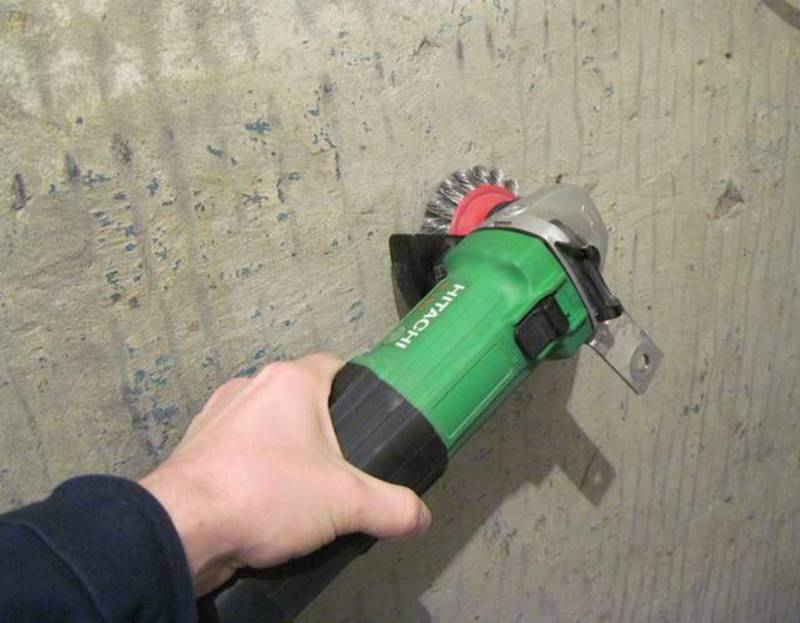
Advantages:
• the process of removing paint does not require investment;
• the resulting notches on the base will give the surface a roughness, which is ideal for subsequent tiling.
Disadvantages:
• the success of the work depends on the correct angle of inclination of the ax blade;
• When performing notches and stripping, dust rises in the room, therefore protective equipment (clothing, glasses, respirator) is required.
It should be noted that it takes a lot of time to remove paint by mechanical method. Moreover, the operating period is shorter than the waiting time for dust shrinkage. It takes a 20 minute break for a punch nozzle to pass through for one minute. It will not be possible to speed up the process by moistening; the saved time will be spent on cleaning the dirt from the floor.
Removing paint with high temperatures
Under the influence of high temperature, the old paint begins to melt, as a result of which the coating swells and begins to bubble. After such a reaction, it remains to remove the raised layer with a spatula or scraper. It is ideal to use a construction hairdryer as a source of hot air. It is directed to a specific area and bubbles are expected to appear.

There is no dust during the work. The removed paint can be sent straight to the trash can. This will save time on cleaning the premises. In addition, there is no need to peel off layers of flooring that have adhered to the floor.
For all the advantages of the method, some caution should be exercised. All paints peel off easily when heated, some of them increase adhesion to the base, they are literally baked on it
Therefore, it is recommended to test the technique on a small fragment of the wall.
Each method deserves attention, but safety should be a priority. If the ideal solution is difficult to find, then several methods are allowed, which are most suitable for a specific section of the wall.
Removing paint from walls without toxins
Taking into account the toxicity of the previous methods, the mechanical method seems to be the safest, albeit more laborious. If you often have to deal with such cases, adopt several mechanical methods, and you will be sure of your health. The easiest and most time consuming way is to peel off the paint with an ax. To begin with, notches are made - diligently, at an angle in order to knock off as large a piece of paint as possible, and then the wall is wetted with water. Through the notches, moisture will penetrate into the concrete surface and reduce its adhesion to the paint layers, making it easier for you to clean it up.
But with the help of quite ordinary tools, work can be accelerated at times. For example, using a grinder with a wide range. The disadvantage of this method is a huge amount of dust, so you also can't do without a respirator and glasses. Alternatively, you can use a chain attachment screwed onto a conventional drill. The nozzle consists of several chain links that, when rotating, knock the paint off the surface
The method is cheap and effective, but you need to work carefully - at any moment a link can fly off the chain. In this case, the link for balance must be removed from the opposite side.
Unlike a grinder, the chain knocks down pieces of paint without generating a lot of dust.
Of course, mechanical methods cannot be used if, as a result, we need a flat surface - along with the paint, pieces of concrete will chip off the wall. But such a surface will be ideal for the subsequent laying of tiles or plastering. Fortunately, acrylic paint is much easier to remove - just use a metal bristle brush or coarse sandpaper. True, this method works when there are not many layers of paint. In any case, you can apply the above methods. If you plan to paint the surface with the same paint, it is not necessary to clean off the previous layers.
Determining the type of paintwork
Determine the type of coating you need to select a chemical solvent, if you decide to resort to it. For information about what paint the remover is intended for, look on the packaging, since there are a lot of manufacturers and it is impossible to describe all of them in one article.
By default, the walls in the bathroom can be painted with oil, enamel, acrylic, latex paint. Some formulations use special preparation methods for disposal. Therefore, at the initial stage, it is necessary to determine the type of paintwork materials on the concrete surface:
-
acrylic - it is deeply absorbed into the base, it is cleaned fragmentarily with a spatula;
- silicate - the basis is liquid glass, the film layer is very durable, it is difficult to scratch it;
- silicone - the most elastic composition of all existing paints after drying;
-
oil - usually glossy, curls up when moistened with acetone, solvent;
- latex - a stain will remain on a rag moistened with alcohol (vodka) after intensive wiping of the wall in a small control area;
- enamel - it is easy to confuse with oil because of the glossy surface, but the solvent is included in the composition initially, does not cause folding.
In its composition, water-based paint may contain latex, acrylic, silicone, silicate. Water in this case is a solvent that completely evaporates when it dries. After that, it is no longer possible to quickly wash off the resulting film on the walls with water.
Thus, to peel the existing paintwork on the walls of the bathroom, you can use hand-held, electric, battery-powered, networked tools. Chemical reagents-removers or heating with a technical hair dryer can greatly simplify the work and increase their productivity.
What to consider when choosing a paint stripping method?
Before embarking on labor-intensive and long-term work, it is necessary to understand what we are dealing with and try to find a method that will nevertheless prove to be the most effective with the least labor and time
To do this, you need to pay attention to five determining factors:
- Determine how much money you are willing to spend on the purchase of the necessary instruments or solutions, and whether you are ready at all;
- What time do you have. After all, it so happens that the employee whom you hired to lay the same tile is suddenly released before the agreed time and is ready to start work at your home in a day. Then you will have to prepare the walls at a very fast pace;
-
The type of foundation also plays an important role. It can be plaster, cement, brick or concrete;
- Paint type - acrylic, water-based, oil or enamel. Of course, it is very difficult to do this by visual inspection, but it is still possible to distinguish the oil composition from others. Let's say right away that the most difficult thing will be to remove oil paint from a concrete base;
-
And the last is the number of paint layers. A thin layer is sometimes much more difficult to remove than a thick one, which, upon impact, breaks off in plates due to its own rigidity.
And the best thing is to "try it out" and on a small section of the wall try to remove a fragment of paint by each of the methods in turn, starting with the simplest ones.
Removing paint without the use of chemicals
The first and simplest thing is to arm yourself with a hammer and a chisel, and beat off the old paint centimeter by centimeter. This approach to this problem has its advantages and disadvantages. The main advantage of this method is obtaining a high-quality cleaned surface without unnecessary dust and waste.
At first glance, such a "correct solution", when trying to try it in practice, runs into multiple complications.
- Firstly, not every person is physically able to hammer on the wall with a hammer for a considerable time.
- Secondly, such a continuous noise made by you will not bring popularity among the neighbors.
- Thirdly, the time spent in this lesson could be used for other more useful purposes, and you will have a lot of time to set off a large room.
This method of removing paint and varnish is best suited for beating paint in hard-to-reach places, in the corners of a room, in places where there is a possibility of damage to something.
To remove paint in the bathroom using this method, you will need a hammer and a set of different chisels. You can pick them up in almost every hardware store.
It should be borne in mind that the chisel will gradually become dull and you will need several (from two or more) pieces.
Removing paint with a punch and grinder.
There is also a more effective way to solve the problem of how to remove paint from the bathroom wall - using a grinder and a punch. This is the fastest and most reliable way to achieve your goal.
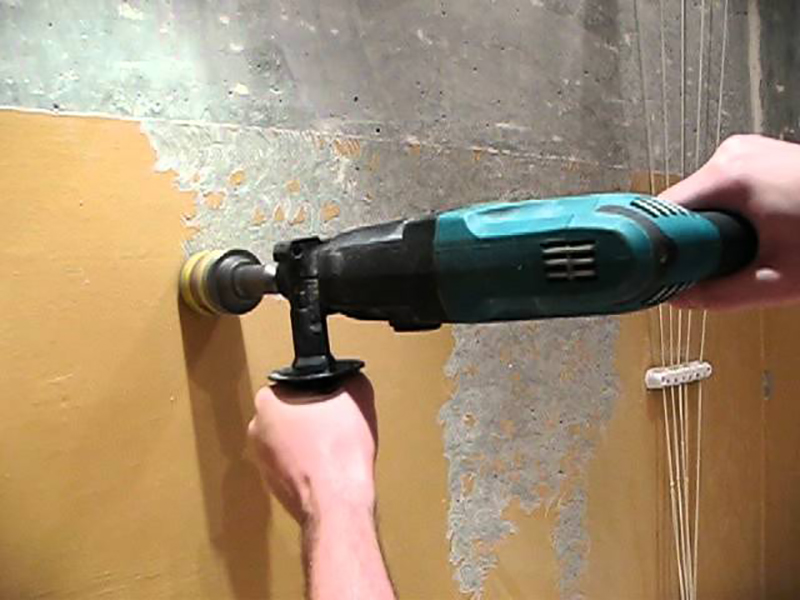
A cord brush is placed on a drill or grinder and the coating is removed from the whole plumbing room with longitudinal translational movements in just a couple of hours.
The advantages of this method include:
- the speed with which the robot is executed;
- slight physical effort, in the case of skills, robots with equipment.
The disadvantages include:
- incredible noise emitted by the equipment during the robot;
- uncleaned places remain in hard-to-reach areas;
- a lot of dust;
- use of electricity and replaceable brushes.
In practice, this method of paint removal requires compliance with safety standards. Due to the large amount of dust, you must use a respirator or gas mask. It is also necessary to carefully close the room in order to prevent the spread of this dust around the apartment, use overalls and hats, take short breaks so that the dust can settle on the floor.

This is the most effective method for removing paint and varnish, it will also help in cases where paint has been applied to a concrete primer.
Removing paint with a construction hair dryer.
You can also remove the old paintwork with a construction hair dryer. It is impractical and sometimes impossible to use this approach over a large area. If the paint is well absorbed into the surface of the wall, its heating can lead not to peeling, but to the opposite process. She can simply "stick" to the concrete tightly.
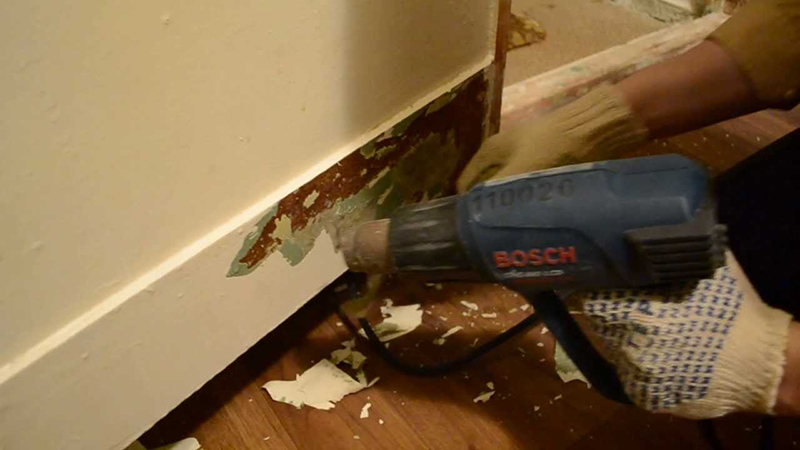
But with a hair dryer or other heating element, it is great to work in areas where you cannot reach with a brush or you cannot hit the surface. In these areas, the paint heated by a hair dryer is carefully cleaned off with a spatula.


